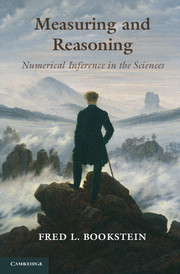Book contents
- Frontmatter
- Dedication
- Contents
- Analytical Table of Contents
- Preface
- Epigraphs
- Part I The Basic Structure of Numerical Inference
- 1 Getting Started
- 2 Consilience as a Rhetorical strategy
- 3 Abduction and Strong Inference
- Part II A Sampler of Strategies
- Part III Numerical Inference for General Systems
- Part IV What Is to Be Done?
- References
- Index
- Plate section
1 - Getting Started
from Part I - The Basic Structure of Numerical Inference
Published online by Cambridge University Press: 05 March 2014
- Frontmatter
- Dedication
- Contents
- Analytical Table of Contents
- Preface
- Epigraphs
- Part I The Basic Structure of Numerical Inference
- 1 Getting Started
- 2 Consilience as a Rhetorical strategy
- 3 Abduction and Strong Inference
- Part II A Sampler of Strategies
- Part III Numerical Inference for General Systems
- Part IV What Is to Be Done?
- References
- Index
- Plate section
Summary
Our Central Problem: What Is a Good Numerical Inference?
You know this move. You have seen it dozens of times, or thousands if you have been a scientist or professor for long enough. A text or a PowerPoint slide presents some arithmetic computation based on measured data – group averages, or a regression slope, or the range of some measurement, or a bar chart or time series – and then the author continues, “So I have shown…” or, more conspiratorially, “We have thus shown…” or, more didactically, “It follows that…” where the in all cases is some proposition more general or otherwise more assertive than the scope of the data actually reported. The qualitative assertion may deal with a cause, or a consequence, or a generalization about past, hypothetical present, or future under some eutopian or dystopian policy. Or the sentence may be a bit more sophisticated, with the same import: “Hence our null hypothesis is rejected” or, the form with the most internal evidence of thoughtfulness, “Hence Professor Smith's theory is false.”
Here are a few examples unsystematically extracted and rephrased as single sentences from later in this book. “It followed that the submarine was traveling east.” “The two continental plates are moving apart at a rate of about four centimeters per year.” “Cholera is caused by some morbid material in your drinking water.” “There was an anthrax epidemic in Sverdlovsk, Russia, in 1979, that originated in a secret biowarfare factory.” “Einstein's law of the photoelectric effect is correct.”
- Type
- Chapter
- Information
- Measuring and ReasoningNumerical Inference in the Sciences, pp. 3 - 16Publisher: Cambridge University PressPrint publication year: 2014



